Silverblade Paladin is the bearer of the Soulbond mechanic. I shall dedicate this article to that ability.
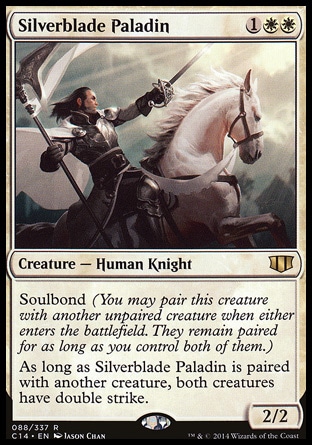
Oracle Text:
Creature — Human Knight
Soulbond (You may pair this creature with another unpaired creature when either enters the battlefield. They remain paired for as long as you control both of them.)
As long as Silverblade Paladin is paired with another creature, both creatures have double strike.
To be honest, the reminder text for Soulbond that’s printed on cards puts me in countenance, because it is “slightly” discordant with what’s written about Soulbond in Comprehensive rules. So don’t trust the reminder text, it’s a lie! =)
In fact, Soulbond is an ability keyword representing two triggered abilities. And those are not just any triggers, but conditional ones (and that part is completely omitted in the italic text). Let’s take a good look at the rules.
702.94a. Soulbond is a keyword that represents two triggered abilities. “Soulbond” means “When this creature enters the battlefield, if you control both this creature and another creature and both are unpaired, you may pair this creature with another unpaired creature you control for as long as both remain creatures on the battlefield under your control” and “Whenever another creature enters the battlefield under your control, if you control both that creature and this one and both are unpaired, you may pair that creature with this creature for as long as both remain creatures on the battlefield under your control.”
“When this creature enters the battlefield” and “Whenever another creature enters the battlefield under your control” are triggering events. The abilities have a chance to trigger only when a triggering event occurs. The first trigger waits for a creature with Soulbond to enter the battlefield (nobody cares how exactly it does that). The second one needs the creature with Soulbond to be on the battlefield, and waits for another creature to enter the battlefield under your control (doesn’t matter if the entering creature has Soulbond or not).
“if you control both this creature and another creature and both are unpaired” is a condition. If the condition is not met, the trigger will simply not go off, even when the triggering event occurs. The condition being met is also required as the conditional trigger resolves — another check is performed at this time, and if the condition is not met, the trigger does not resolve.
Finally, “you may pair…” is the effect, i.e. what happens if the ability resolves successfully.
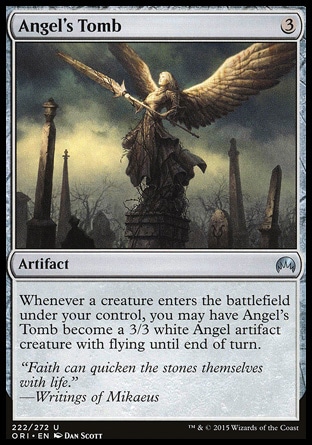



If Silverblade Paladin and another creature enter the battlefield simultaneously, Silverblade Paladin’s trigger goes off, because all permanents including the incoming ones are checked on any enter-the-battlefield effect. Both conditions are met — you control both creatures, and they are both unpaired.
Two of every sort
A creature that is to be paired with a creature with Soulbond is chosen on resolution of the Soulbond trigger. If a player is hasty and chooses the creature before the trigger is supposed to resolve, he or she must abide by that choice, unless his opponent takes an action, and as long as the choice remains legal. If an opponent does take an action, you may feel free to reject your word and change your mind. Naturally, as you change your mind you may still only choose an unpaired creature you control (because that is exactly what the effect instructs to do).



In order to trigger Silverblade Paladin, you either need to animate Angel’s Tomb previously (and it must be unpaired), or control another unpaired creature.
Suppose you control a non-animated Angel’s Tomb and an unpaired creature. As Silverblade Paladin enters the battlefield you get two triggers: one of Angel’s Tomb and one of Silverblade Paladin. Since you control both triggers, you may choose the order in which you put them onto the stack. If you place the Paladin’s trigger first, then the Angel’s Tomb’s one above, you will be able to pair the Angel (animated Angel’s Tomb) with the Paladin, if by the time the last trigger resolves, both the Angel and the Paladin are under your control and are still unpaired.
The text of Soulbond’s triggers does not contain the word “target”, which means these abilities are not targeted. Since you have to choose, not target, you may pair with a creature with Shroud, and with Protection from any property of the other creature.
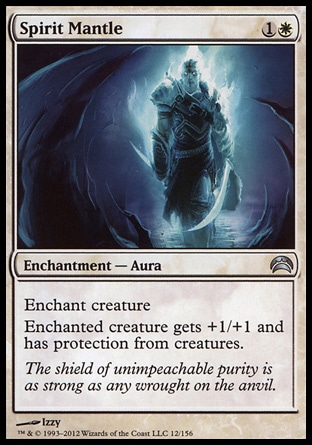
Protection from creatures cannot prevent you from pairing the creature enchanted with Spirit Mantle with the creature with Soulbond.
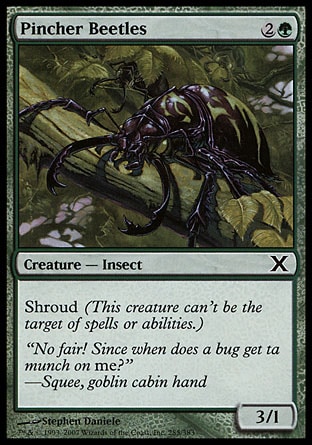
Pincher Beetles cannot become the target of spells or abilities, but Soulbond triggers do not target. Pairing is possible.
Pairing only happens if both permanents are creatures, are controlled by the related player, and are unpaired. Thus, if you break any of these conditions, you can hinder the pairing:

You can snatch a creature before Soulbond resolves.

You can remove one or both creatures from the battlefield.
Besides, the trigger may be countered, Disallow is your tool.
A creature may be paired only with one other creature. That’s why pairing is not possible if by the time the trigger resolves one or both creatures are already paired. This can happen for instance when multiple Soulbond triggers go off at the same time (remember that if there are no unpaired creatures, the trigger doesn’t go off at all).
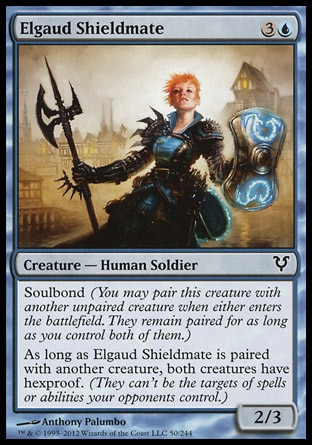

Suppose you control Silverblade Paladin and Elgaud Shieldmate, both unpaired. As a Bear enters the battlefield, two triggers go off. By putting Silverblade Paladin’s trigger onto the stack first, followed by Elgaud Shieldmate’s one, you may pair the Bear with Elgaud Shieldmate, but then as Silverblade Paladin’s trigger resolves, the Bear will already be paired, so you cannot pair it with the Paladin even if you want to.
Soulbond triggers are not compulsory. Their text contains the word “may”, which entitles its controller to choose whether or not to pair.
Besides, if a player misses the Soulbond trigger, it is considered that he or she decided not to pair. Such a mistake does not earn a punishment in competitive events, but there’s no chance to go back and resolve the trigger differently either.
Bound by one goal, Linked by one chain
Nautilus Pompilius
What Soulbond gives to creatures is defined by the static abilities of those creatures describing a certain bonus that lasts as long as the pair exists.

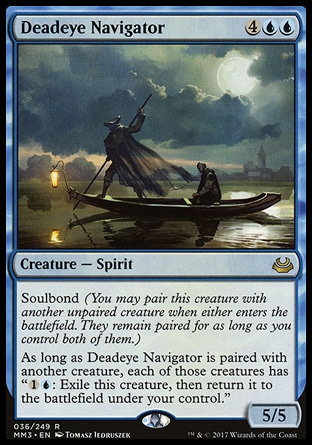
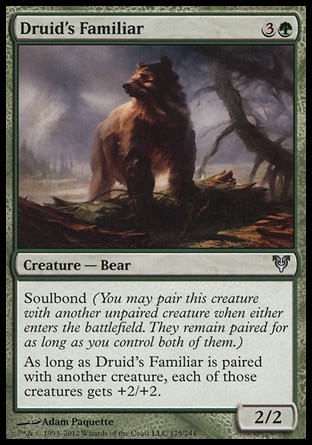
The bonus may be of any kind: a static ability, as Silverblade Paladin’s, or an activated ability, like that of Deadeye Navigator, or just some effect that changes the creatures’ characteristics, like the one of Druid’s Familiar.
If a creature with Soulbond is paired with another creature with Soulbond, both get bonuses of each other, since they have two static abilities for their pair.
If the bonus is an ability, both paired creatures get their own instance of that ability. Those abilities do not depend on each other.
If the text of such an ability contains the words “this creature”, it only refers to the creature it is on, not the one paired with it.
The fact that the creatures are paired is the result of Soulbond’s trigger resolution. “Paired” doesn’t mean anything other than that. The creatures remain absolutely independent. They may attack or block separately, they become targets of spells and abilities individually, etc. Any actions taken towards either of the paired creatures do not affect another (unless, of course, the effect’s text explicitly states so).

If an effect impacts a creature paired with the target creature, it will say so in the effect’s text.
If such a spell is countered for any reason, none of the creatures falls under its effect.
Whether the target creature is paired or not is checked once — when such a spell resolves.
If a paired creature loses Soulbond, the pair is preserved. The trigger has already long resolved, and having or not having Soulbond (which represents two triggered abilities) does not impact the current game state.
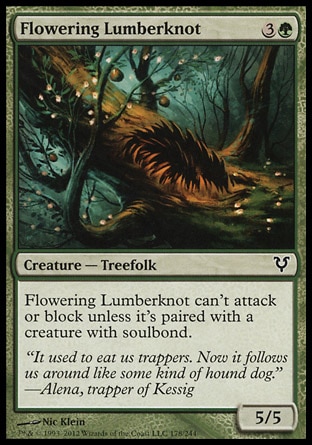
Having or not having Soulbond only matters if the creature’s abilities actually depend on it. For instance, Flowering Lumberknot cannot attack or block if its pair loses Soulbond.
Normally, if a paired creature’s ability is removed, the other creature doesn’t suffer anything special:



Suppose you control Silverblade Paladin and Wingcrafter paired with each other. If either of them becomes the target of Adarkar Windform’s ability, only that creature loses Flying as the ability resolves. The other one continues to have Flying.
It’s an all different thing when a creature loses all abilities including the static ability giving a bonus when it’s paired:

Suppose your opponent controls a Silverblade Paladin and a Bear which are paired.
If you Turn to Frog the Bear, it will simply lose Double Strike until end of turn. It will not affect Silverblade Paladin in any way. It will remain paired with the Bear and continue basking in its Soulbond bonuses.
If you Turn to Frog Silverblade Paladin instead, it will lose all of its abilities including Soulbond, but it will remain paired with the Bear.
Since the effect of Silverblade Paladin’s static ability depends on Turn to Frog’s effect (they both apply at layer 6, and after Turn to Frog’s effect is applied, the other effect ceases to exist), it is applied last. By applying Turn to Frog’s ability first, we erase the Paladin’s ability. So the Paladin will be a blue 1/1 Frog without abilities paired with the Bear, and the latter will be paired with the Frog and will not have Double strike.


The situation becomes even more curious when both paired creatures have Soulbond.
If you cast Turn to Frog on Silverblade Paladin, it becomes a blue 1/1 Frog without abilities, but since it is still paired with Druid’s Familiar, it continues to receive its bonus (getting +2/+2 is not an ability, so it is not removed by Turn to Frog). We shall have a blue 3/3 Frog without abilities. Since Silverblade Paladin’s ability is removed until end of turn, Druid’s Familiar will have the bonus from its own ability, but will not have Double strike.
If you Turn to Frog Druid’s Familiar, it becomes a blue 1/1 Frog without abilities. It will lose its own ability bonuses, and Double strike as well, because it is an ability. Silverblade Paladin will keep Double strike, but will not have Druid’s Familiar’s bonus.
Until death do us part
You cannot just break the pair because you want to. Nothing happens just like that in Magic.
The pair breaks if either paired creature
- becomes controlled by another player;
- stops being a creature;
- leaves the battlefield.
Sounds familiar, doesn’t it? We have just discussed all these maneuvers when trying to prevent an opponent from pairing a creature. But we sometimes want to re-pair our own creatures that are already paired in some way. To do this, we can use another interesting mechanic — blinking.

An animated Angel’s Tomb stops being a creature in the cleanup step. Even if you have paired it with a creature while it was a creature itself, the pair will break.
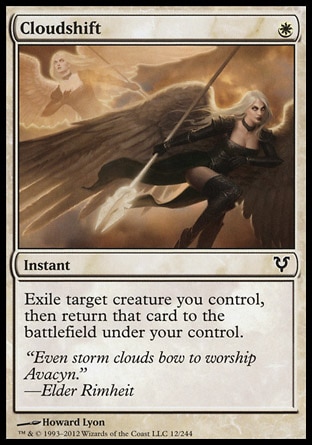
If you blink a paired creature, first of all, the pair will break, and second, when the creature returns, all Soulbond triggers of unpaired creatures on the battlefield controlled by the same player will trigger, and a new pair may be established.
The bonuses last only as long as the creatures remain paired. When the pair breaks, all bonuses disappear. Sometimes this immediately impacts the game, and sometimes does not really affect it in that moment.
Abilities influencing the possibility of blocking or being blocked matter only at the beginning of the declare blockers step. If a creature with Reach blocks a creature with Flying and then loses Reach because its pair has been broken, the creature with Flying is still blocked by that creature, and they assign damage to each other as usual.
If a creature that lost its pair loses the activated ability it had through the pair, it does not impact abilities that have already been activated and are on the stack. Remember the submarine and torpedo model!
If the bonus includes increasing toughness, and a creature loses its pair, this may result in the damage marked on it exceeding its toughness. In this case the creature will be destroyed upon the nearest SBA check.


Paired Silverblade Paladin and Druid’s Familiar both have Double strike and get +2/+2. Not bad.
The cunning opponent first casts Pyroclasm, then Shocks Silverblade Paladin. The Paladin takes 4 damage total and goes to the graveyard as SBA are performed. The pair breaks, Druid’s Familiar shrinks to 2/2 and dies to the lethal damage marked on it when SBA are performed again.
- ⇑ The subtle trick with Mirrorweave consists in animating your land and targeting it with Mirrorweave. Then all other creatures become inanimate copies of that land. Read more details about this in the judge school article about “Attack of the clones, or Copying”.
- ⇑ You need to be aware that the triggers based on creatures with and without Soulbond entering the battlefield function somewhat differently:
If you put a creature with Soulbond onto the battlefield, its trigger goes off under the condition if you control an unpaired creature (with or without Soulbond, matters not). In response, you may break the existing pairs (read through the rest of the article to learn how to do that), then pair the newly-entered creature with any unpaired creature you control.
If a creature without Soulbond hits the field, only triggers of unpaired creatures with Soulbond go off. Paired ones simply won’t react to it. And thus, no matter what you do in response to those triggers, you may only pair with those creatures with Soulbond that were unpaired when the creature entered the battlefield (and that remained so until the moment Soulbond resolved). No tricks can help to pair with an already paired creature. - ⇑ Deadeye Navigator has a very peculiar ability. It “blinks” on resolution. That means, if it was paired, the pair is broken. Since Deadeye Navigator returns to the battlefield, you can pair it again with the same or another unpaired creature.
If you blink its pair, there may be different situations.
Also, you could blink both. To do that, activate the ability of either in response to activating the other’s. - ⇑ Despite the fact that Phasing doesn’t actually change the controller or the zone, the permanent that is phased out is considered non-existing. Continuous effects with text containing “until” that track this permanent cease to affect it. So, when a permanent phases out, its pair breaks (Ref. rule 702.24e.). Also worth of a note, phasing in does not cause any EtB triggers to go off, including Soulbond.
Translated by Witas Spasovski

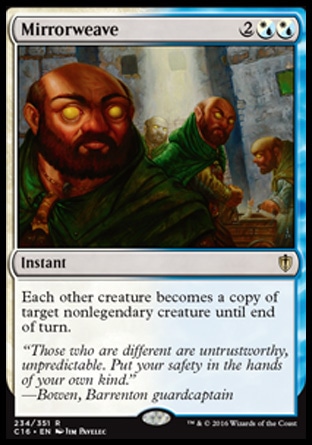
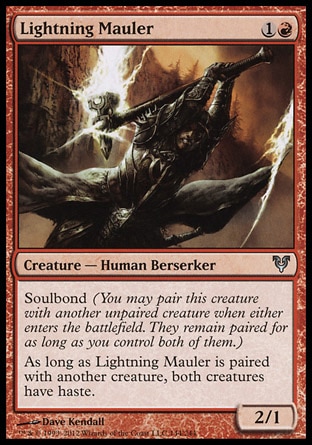
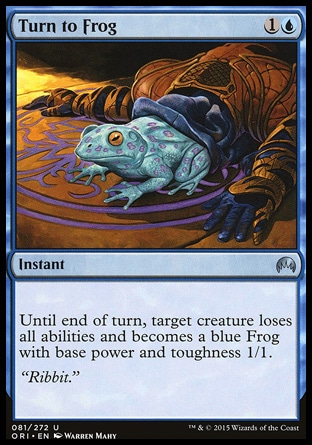
Suppose you have no creatures under your control, but you have an Angel’s Tomb. If Silverblade Paladin enters the battlefield, Angel’s Tomb’s trigger goes off, but Silverblade Paladin’s doesn’t, because the condition is not met.